Ryan Sorsdahl Blog by Joe Jackson
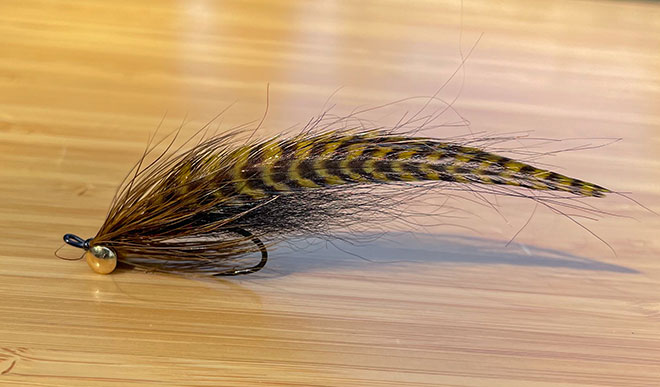
An unnamed, late-season creation of Sorsdahl’s designed to cure missed hookups.
Evolving with Ryan Sorsdahl
Ryan Sorsdahl only caught one steelhead the year he committed to using swung flies only. Such a principle is akin to fishing solely dry flies or hunting with open sights; a personally-imposed challenge that might appear absurd to others, but which can make the difference between what is meaningful and what is not for the one employing it.
Sorsdahl is standing on a high bank above one of the Kenai Peninsula’s fall streams, watching as a steelhead flutters lazily in a pool the size of a bathtub. The air is sweet with decay. Slatey water dashes westward, meeting the Pacific where Captain James Cook reputedly lost his anchor against high winds in 1778. Sorsdahl knows this is a situation in which everything will have to go right in order to hook the fish. The fly will need to get down quickly, it’ll need to be the right color, and it will have to travel at the correct swing speed. Like a sheep hunter in the high country, he begins his stalk. You have to wonder if there are moments when anglers like Sorsdahl second-guess their own principles. He’s had situations where he was staring down a pod of 15 steelhead, none of which offered to buy what he was selling. Years later, on the well-touted Situk, he would spend five days watching others hook and land fish on beads and nymphs while he remained fishless.
Part of Sorsdahl’s reasoning for swinging-only, he tells me over a strong cup of coffee in mid-February, is that he’s constantly evolving. He’s caught trout and steelhead on just about any fly you could want to, but at a certain point he wanted more; to continue his evolution into new patterns and new techniques.
“I want to remember a fish,” he says. “Not just a day. With swinging, I can remember every spot and every take.”
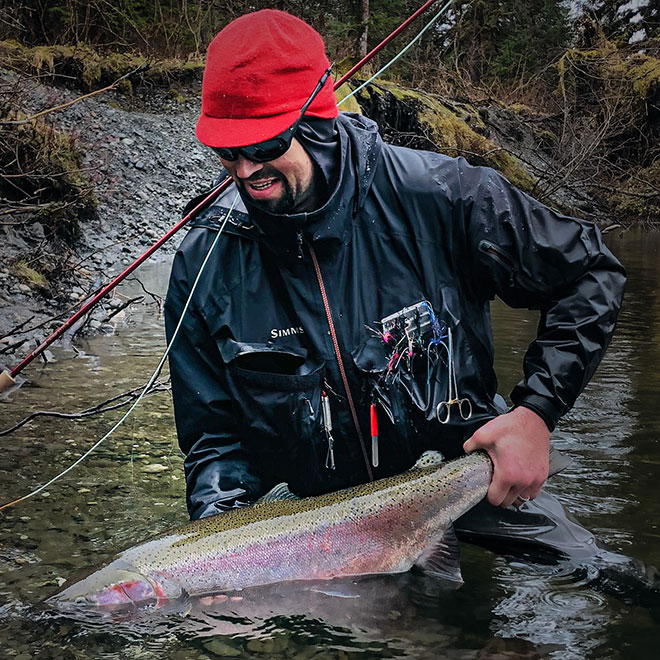
Sorsdahl’s first Situk steelhead on the swing—a fish well-worth the effort.
This probably explains why he can still see and feel his first swung steelhead, caught from and returned to that pool the size of a bathtub while the air reeked of decay—and on his own, meticulously-honed fly, no less. It explains why the memory of his first Situk steelhead, finally coaxed out of a logjam with a black-and-purple Dirty Hoh, will be with him until the day he dies.
Sorsdahl’s entrance into the flyfishing world was about as idyllic as you could ask for. His dad took him fishing in the high-mountain lakes near Tacoma, Washington where he grew up. He mowed lawns every chance he could for the sole purpose of buying more fishing gear, and he unabashedly invaded every fly shop within twenty miles for the latest scoop on things. By the time he was old enough to drive, Sorsdahl was getting up at 3 a.m. and chasing harebrained ideas of new places and new fish. It was one thing to cast a line with a cherished mentor—as any angler who’s grown up under a guiding hand knows—but it was another to seek out his own opportunities, rely on his own devices, and, occasionally, connect the dots enough to allow things to simply come together.
Fly-tying emerged, predictably, as a way to feed this growing obsession. Part of the draw was economical in that he could turn out flies far more cheaply than he could buy them, but a large part of it was the creativity it allowed him to have. As Sorsdahl fished more and more, he came to realize that flies could (and often should) be tweaked to match one’s unique situation; the watershed, the season, even the specific pool and specific fish that lived there. In this way, the actual fishing wasn’t the only aspect of the sport that sucked him into a battle of the wits with feral trout; the tying process itself became like a chess match with an unseen but ever-looming Grandmaster. For Sorsdahl, like everyone else, the years tumbled like water over cobbles and life beyond the vice moved on. He took a job in Anchorage, Alaska as a firefighter and, the changes in his setting and circumstances notwithstanding, discovered that the place felt about as foreign as the moon. His biggest realization was that trout did not key in on bugs in quite the same way that they did in the lower Northwest, and that he would have to evolve—again and again.
Bloom’s Taxonomy is a model by which learning is classified. It’s used by educators the world over (myself included), and it defines stages of content mastery by the complexity of tasks students are able to complete. We begin learning simply by remembering and imitating, taking what others have done before us and replicating their results. Tying the standbys of Woolly Buggers and Copper Johns as a beginner immediately comes to mind. As we progress, we take on the knowledge of a subject that is detailed enough to allow us to analyze and/or evaluate a variety of situations. In Sorsdahl’s case, this is observing a stream and filling a mental ledger with what is there—potential fish migrations, water temperature, depth, forage appearance and behavior, etc.—and how it should impact his time spent at the vice. This process of refinement only escalated during his first forays into Alaskan streams. Now he had to consider seasonal fish migrations, as well as the use of meaty streamers and the annual salmon “hatch.”
It didn’t take long for Sorsdahl to make the critical jump to creating, the pinnacle of Bloom’s Taxonomy and of learning itself. Instead of tweaking existing patterns to suit himself, he was devising, tying, and honing a collection of originals. As the years went by, two things would come to define Sorsdahl’s tying (and, indeed, his angling) style:
First, an affinity for Kenai Peninsula steelhead, which he came to chase recklessly every year, and second, the recognition that catching fish on swung flies was impactful enough to warrant using them exclusively.
Steelhead have captured the fascination of hundreds of thousands of anglers. Anadromy, in general, is a trait among sportfish that has gained a cult following in fly angling sectors, with a membership that will sometimes quite literally quit their jobs and abandon their spouses (if they have them in the first place) for the thought of chromed salmonids. Steelhead are unique in that, yes, they attain the size and weights that you’d expect from swimming around in the salt most of their lives, but they also come and go in such cryptically small runs (at least compared to their salmon brethren) that they’ve become the Pacific Northwest’s own muskellunge; the “fish of a thousand casts;” at least on swung flies.
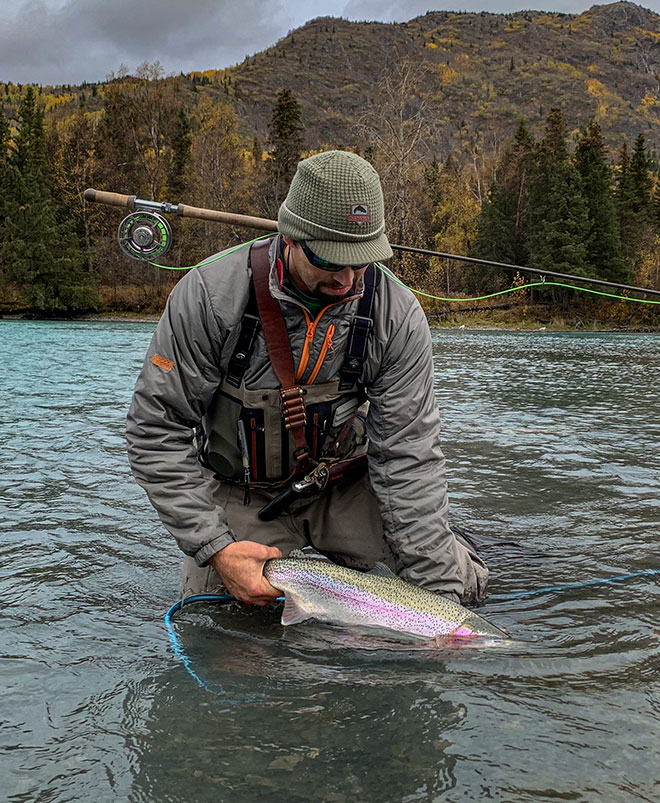
A fall Kenai ‘bow taken on Spey tactics. Swinging up fish is never a sure thing, but Sorsdahl’s evolution has given him a higher probability than most.
Not only was it just more fun for Sorsdahl to hook steelhead, trout, and salmon on the ol’ down-and-across swing, but steelhead became more of a reward and less of a sheer quantity when he had to work for them. He also came to find out that he learned more from the swinging process. While dredging nymphs or beads is reliably effective, it doesn’t require the same levels of observation that swinging often demands. Swinging requires “talking” to the fish through the tiniest of adjustments—a split-second pause at the end of a drift or a slightly longer mend, perhaps—and often, the conversation is one-way. Sorsdahl came to know well the emotional rollercoaster that swinging flies can take anglers on. It might be hours, days, weeks absent of fish, and this can turn to sheer agony at not knowing if what you’re doing is the right thing. You might consider swapping to a bead. And then it might be one fish, one take, and if you’re anything like Sorsdahl, you’ll rush back to the vice because you’ve opened the channels of communication, if only briefly, and can adapt yet again.
As he learned the technique on the water, Sorsdahl also started specializing in tying swinging patterns. Books such as Dec Hogan’s A Passion for Steelhead, Hogan and Marty Howard’s Tying Steelhead Flies with Style, and Modern Steelhead Flies by Jay Nichols and Rob Russell served as requisite inspiration. Through various years and stages of iteration, Sorsdahl came to decide what materials he liked and didn’t like, at what weights to concoct flies, and how to vary his tying style to match a myriad of situations on the water. He even began to alter steelhead flies for Alaskan resident trout.
The resulting patterns are, hands-down, some of the most durable, thoughtful, and pretty flies I’ve ever seen. Sorsdahl makes things complicated but in a way that does justice to nature. Where leeches and sculpins are infinitesimally layered with iridescence and semi-transparency, Sorsdahl’s imitations are, too. I ask him why it is that, when the fly-tying industry has proven that you can achieve a perfectly effective leech imitation with nothing but a strip of dyed bunny, he includes half a dozen furs and feathers and spends perhaps twice the amount of time (or more) to tie it all together? His answer is obvious, yet profound:
“Pretty fish deserve pretty flies.”
It’s the same reason upland gunners chase quail from behind the triggers of $5,000 side-by-sides, the same calling that drives anglers to fish, often impractically, with shafts of bamboo and genuine gut leaders. It’s not for the sake of effectiveness (though in Sorsdahl’s case it very well may be), but instead for nostalgia, for romance, for art. For doing justice to the quarry.
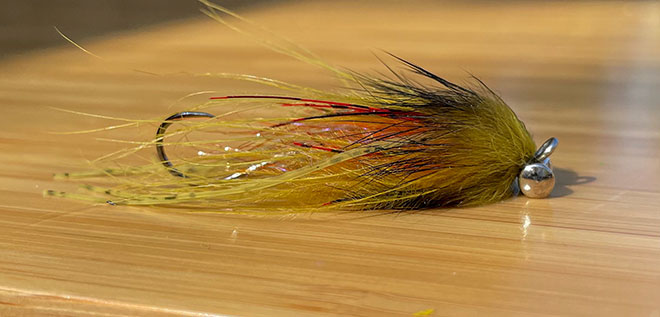
The Tempter in olive n’ orange. This fly has become the author’s absolute favorite.
Around the time that Sorsdahl really started honing his craft and unveiling a handful of highly-refined creations, he opened Bigfoot Custom Fly as a means to share his patterns with others and fund further tying endeavors. One of Bigfoot’s more popular patterns is called the Tempter, a flowy, articulated sculpin in which I have yet to find a flaw. It gets down quickly, owing to a superbly balanced heft and streamlined materials, and on relatively small streams you can access all the water you need to even without a sink-tip. If this sounds like a sales pitch, that’s because it is. The Tempter has saved my bacon on multiple occasions where trout had otherwise gone lockjaw for the variety of egg imitations I threw their way. Please allow me to shout it from the rooftops.
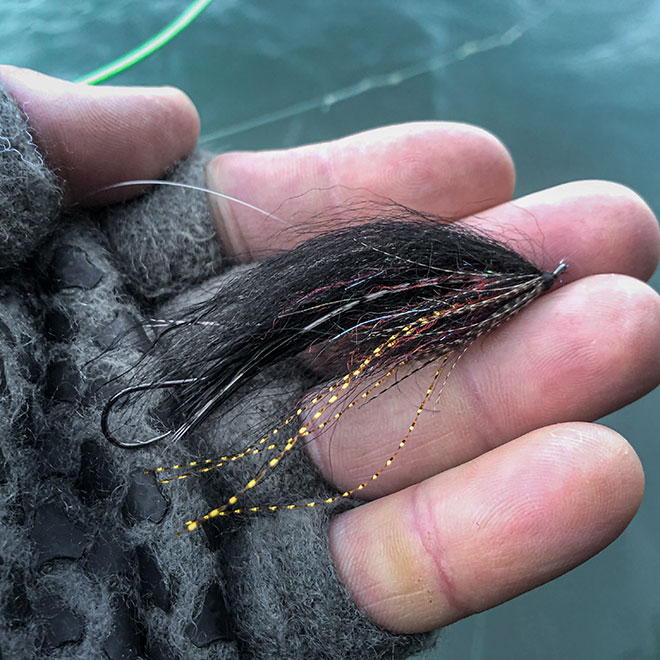
The Bad Intentions Leech in its element: late season trout swinging on the Kenai.
The Bad Intentions Leech is another magic bullet, and one that was still in the works until recently. Based loosely on Ed Hepp’s Underachiever, the Bad Intentions is Sorsdahl’s go-to pattern for trout (and sometimes steelhead). His priorities with this pattern were durability (hence the use of fox instead of marabou), castability (no bunny strips here), and finding harmony between the fly’s weight and a sinking line. I have to say, it achieves all of these things wonderfully.
The Bad Company Sculpin is another tantalizing creation, and Sorsdahl ties different versions for the Kenai than he does for, say, Willow Creek. The primary consideration with this fly, Sorsdahl asserts, is its silhouette. He uses a Scandinavian-style, multilayered wing of fox to achieve this. The arrangement is tied in facing forward, and through a series of wraps that will also finish out the head of the fly, the wing is folded back and propped upright to achieve the flatheaded profile indicative of the lordly sculpin.
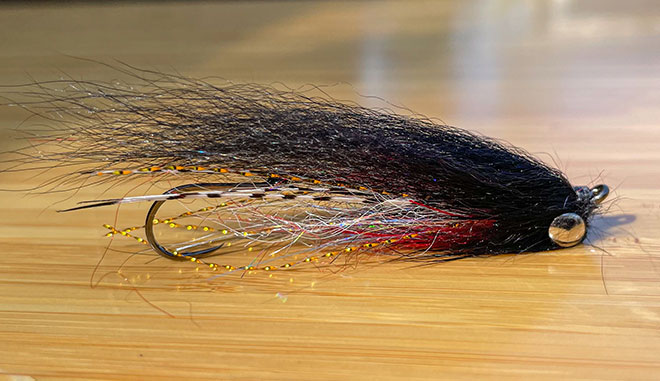
The Bad Company Sculpin in black and red. Note the Scandi-style wing that’s tied in facing forward but coaxed backward by wraps on the head.
While he does tie smaller wet flies and even dries, Sorsdahl has remained committed to tying mostly swinging flies. Sorsdahl swears that tying Spey-style flies, in particular, has made him a better all-around tyer. You have to be precise down to the number of strands of ostrich herl you use or to which millimeter you begin and end a prop of Schlappen. Some of these creations are imitations—sculpins and leeches—while others, mostly bound for steelhead, are as brightly colored as a children’s cartoon and can be seen to represent anything from krill to Christmas ornaments.
Individually, these creations represent distinct processes of development; together, they display an angler’s evolution.
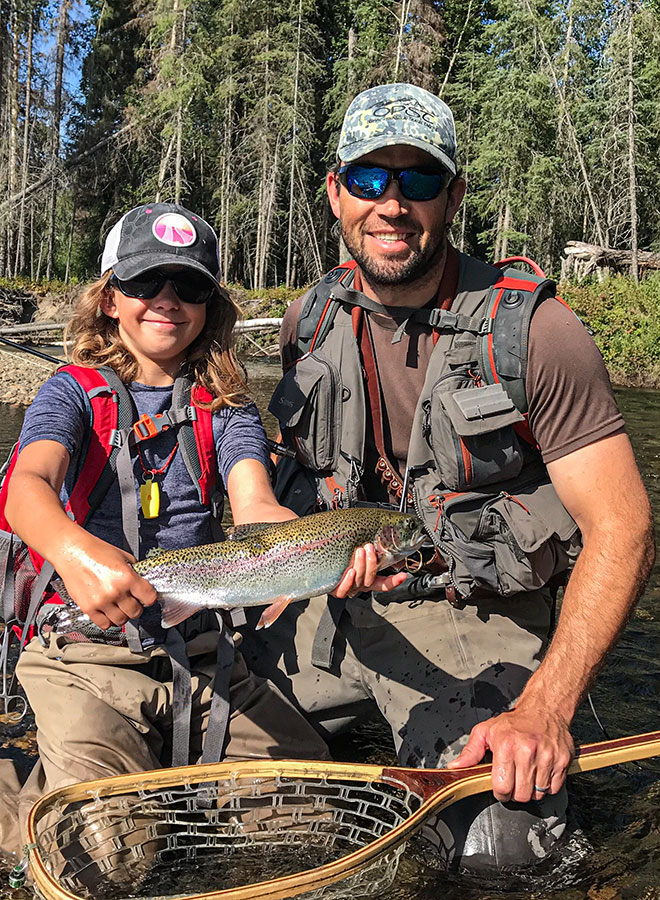
Tegan, Sorsdahl’s youngest, when she began to crack the code of summertime rainbows.
Each of Sorsdahl’s fly boxes tell a story of what came before; they tell of previous years, of triumphs and failures, of weather changes, of subtle yet irreversible shifts in the passage of a stream. They don’t tell stories of 50-fish days, where each trout and its identity are lost to the masses. Instead, they relay the stories that he’s come to cherish, such as his daughters’ (Tegan and Corra) first trout on mouse flies, or when they began to figure out how to look at a river and predict what was happening under the surface. They tell of individual takes, of fish that Sorsdahl can remember right down to where they were hooked in a run and how they flexed and disappeared when he released them. These are the tales he doesn’t even need photographs to remember, because each one of them etches itself somewhere in his soul as immortal proof that fish aren’t the only ones hooked.
In the highest praise one angler can give to another, I can safely say that Ryan Sorsdahl will continue to evolve. His fly boxes will go on to tell more stories, his boots will tread new riverbanks, and his vise will clamp even prettier creations for even prettier fish. I, for one, can’t wait to see what he comes up with next.
Joe Jackson is a fly nerd who wishes to thank each and every subject of “Behind the Vice” for indulging his curiosity. Joe has written for Fish Alaska, The Flyfish Journal, The Drake, and American Fly Fishing, and his favorite flies to tie these days are anything that might appeal to cohos. You can find Ryan Sorsdahl on Instagram @bigfootcustomfly.
